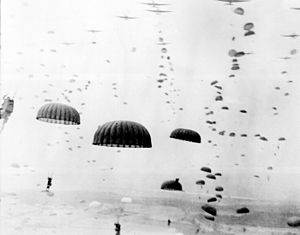Operation Market Garden
| Operation Market Garden | |||||||
|---|---|---|---|---|---|---|---|
| Part of the Allied advance from Paris to the Rhine | |||||||
 Waves of paratroopers land in the Netherlands during Operation Market Garden in September 1944 |
|||||||
|
|||||||
| Belligerents | |||||||
|
|
|
||||||
| Commanders and leaders | |||||||
|
|
|
||||||
| Strength | |||||||
| 41,628 airborne troops 1 armoured division 2 infantry divisions 1 armoured brigade |
Unknown | ||||||
| Casualties and losses | |||||||
| 15,326–17,200 casualties 88 tanks 144 transport aircraft |
incomplete estimates: 3,300–13,300 casualties 30 tanks and SP guns 159 aircraft |
||||||
Operation Market Garden (17–25 September 1944) was an unsuccessful Allied military operation, fought in the Netherlands and Germany in the Second World War. The operation was split into two sub-operations:
Market Garden contained the largest airborne operation up to that point.
Field Marshal Montgomery's strategic goal was to encircle the heart of German industry, the Ruhr, in a pincer movement. The northern end of the pincer would circumvent the northern end of the Siegfried Line giving easier access into Germany. The aim of Operation Market Garden was to establish the northern end of a pincer ready to project deeper into Germany. Allied forces would project north from Belgium, 60 miles (97 km) through the Netherlands, across the Rhine and consolidate north of Arnhem on the Dutch/German border ready to close the pincer.
The operation made massed use of airborne forces, whose tactical objectives were to secure the bridges and allow a rapid advance by armored ground units to consolidate north of Arnhem. The operation required the seizure of the bridges across the Maas (Meuse River), two arms of the Rhine (the Waal and the Lower Rhine) together with crossings over several smaller canals and tributaries.
Several bridges between Eindhoven and Nijmegen were captured at the beginning of the operation. Lieutenant-General Brian Horrocks' XXX Corps ground force advance was delayed by the initial failure of the airborne units to secure bridges at Son and Nijmegen. German forces demolished the bridge over the Wilhelmina Canal at Son before being secured by the 101st Airborne Division. The 82nd Airborne Division's failure to capture the main road bridge over the river Waal at Nijmegen before 20 September also delayed the advance of XXX Corps.
...
Wikipedia
